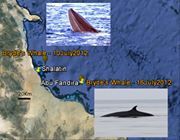You too might encounter one, get prepared to recognize it!
It is not a widely known fact that the Red Sea is inhabited by the gentle giants of the sea, the whales. Three different species are known to dwell in its waters: the Humpback whale (Megaptera novaeangliae), the Minke whale (Balaenoptera acutorostrata) and the Bryde’s whale (Balaenoptera edeni). Among these species however, only the Bryde’s Whale is considered common in the Red Sea, being regularly encountered in in the southern Egyptian Red Sea and off the Saudi coast, in particular in the nutrient-rich waters of the south. This species is the least well-known of the large baleen whales worldwide thus every little piece of info is precious. In July the HEPCA Cetacean Research Unit were lucky enough to make two different sightings of this species. On the 10th of July at least one adult individual (although most probably another 2 or 3 whales were roaming around) was spotted about 20 km off Shalatin. The whale was coming out of the water almost vertically, allowing the researchers to take a clear and valuable shot of the whale’s head, which is the most distinctive external characteristic. The presence of three prominent ridges on the rostrum, running from just behind the tip of the snout to anterior of the blowholes, is what distinguishes the Bryde’s whales from other whales. Bryde’s whales feed mainly on pelagic schooling fish such as pilchard, anchovy, sardine, mackerel and herring as well as small crustaceans. They surface vertically with mouth agape taking a large mouthful of food and water, expanding their throat and dislocating the lower jaw from the upper jaw. The tongue then pushes the water out through gaps between the baleen plates trapping their prey on the inside fringed edge of the baleens. It is not clear in this case, if the whale was feeding as the mouth was closed when surfacing. Six days later the same individual (photo-identified) was sighted again, travelling close to Abu Fandira, an offshore reef South of Shalatin, 25km away from the closest point ashore. The locations of the two sightings are almost 70km apart, an easy distance for this species to cover - it is considered the fastest and most agile among its family (Balaenopteridae). It is generally believed that they swim around 2-7 km/h, but can reach 20–25 km/h. Adults can grow to up to 15m in length and their blow can reach 4m in height although sometimes they blow or exhale while under water, making them difficult to spot. They regularly dive for about 5–15 minutes (maximum of 20 minutes) after 4–7 blows and achieve depths of up to 300 m. When diving, these whales seldom display their flukes. If you are lucky enough to encounter one of these marvellous creatures, please share the sighting with us, it will help us better understanding the seasonal movements of these animals and will contribute to their conservation. Photographs are always valuable too, it may even lead to a positive identification of an individual animal. It is important to always remember to approach the animals slowly, keeping a clearance distance of at least 50 meters and let them decide if and how to interact with your boat. Rapid, un-heeding approach will almost certainly signal the end of the encounter.



